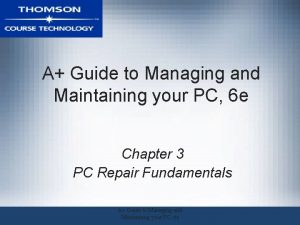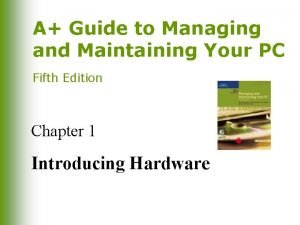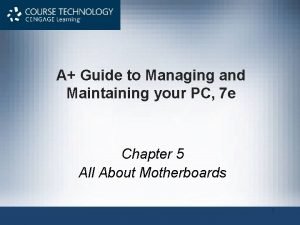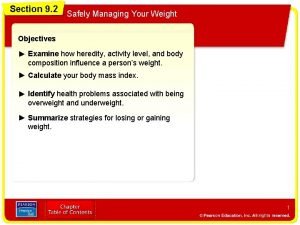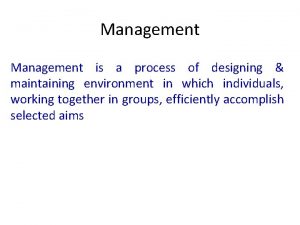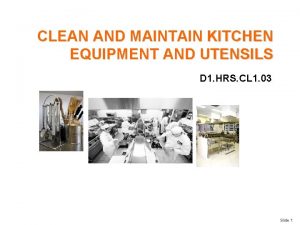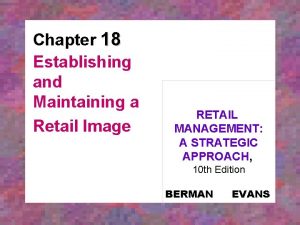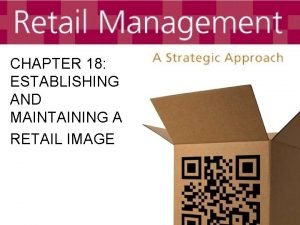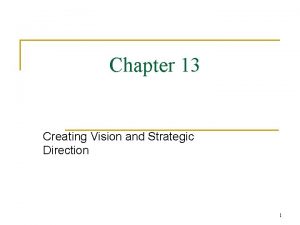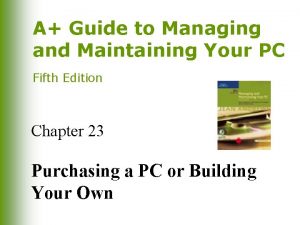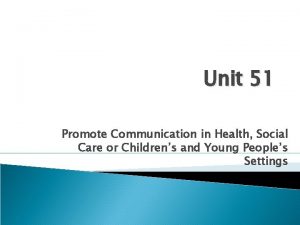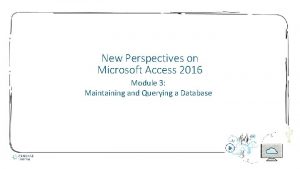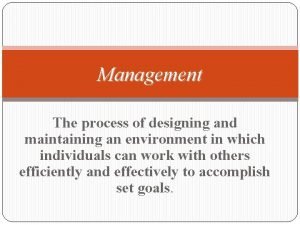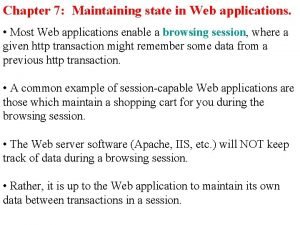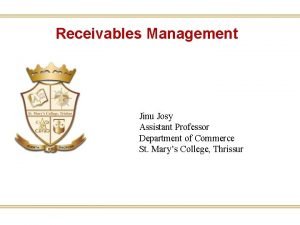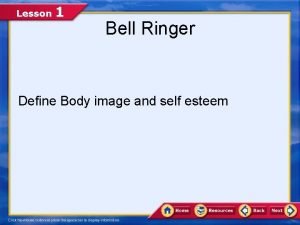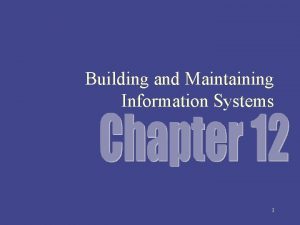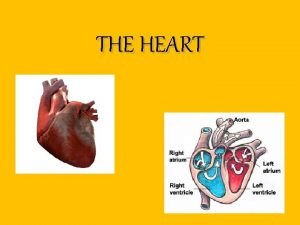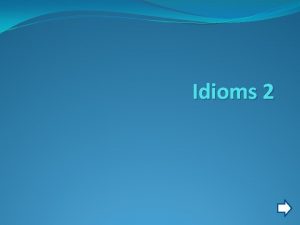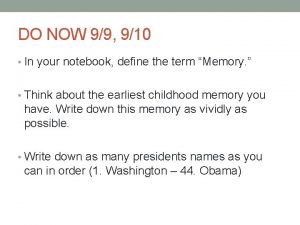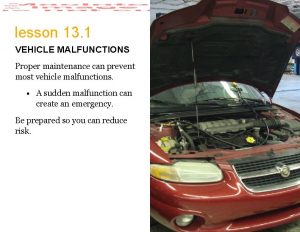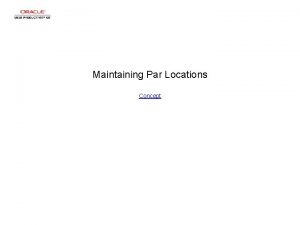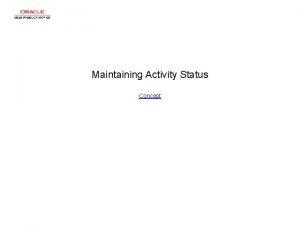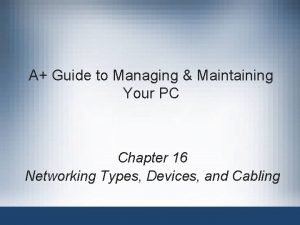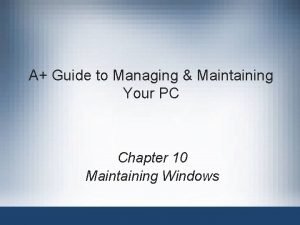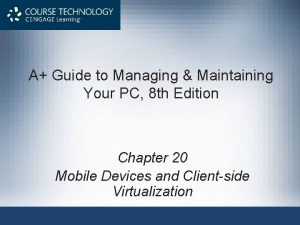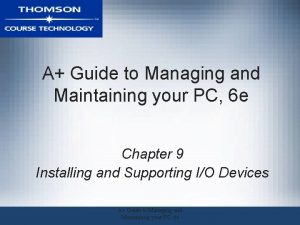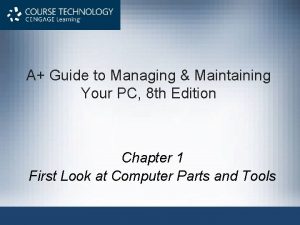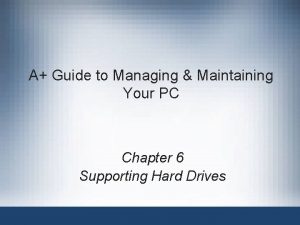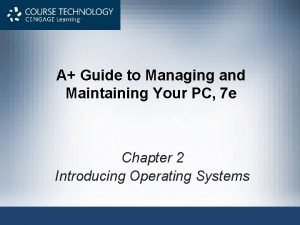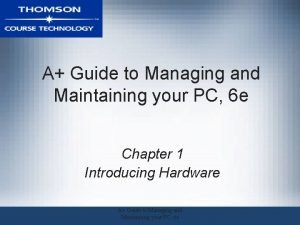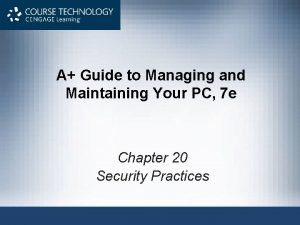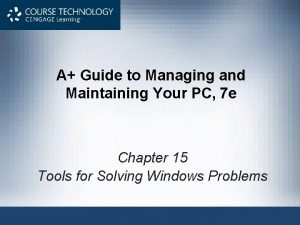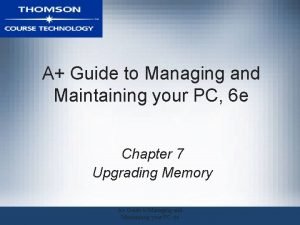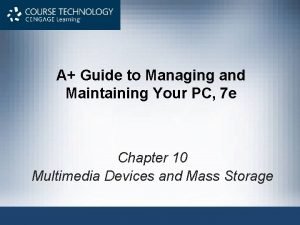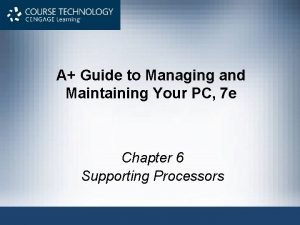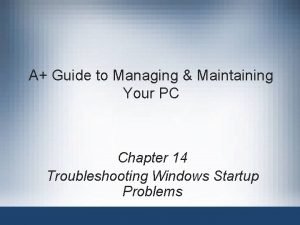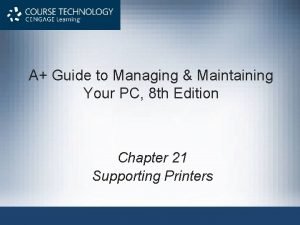A Guide to Managing Maintaining Your PC 8

























































- Slides: 57

A+ Guide to Managing & Maintaining Your PC, 8 th Edition Chapter 3 Introducing Windows Operating Systems

Objectives • Learn how to use Windows to interface with users, files and folders, applications, and hardware • Learn about some Windows tools that you can use to examine and support the system A+ Guide to Managing & Maintaining Your PC, 8 th Edition © Cengage Learning 2014 2

Using Windows • Operating system (OS) software – Controls a computer • Four main functions of all OSs – – Provide a user interface Manage files Manage hardware Manage applications • Windows 7 is an upgrade to Windows Vista • Every PC support technician needs to be a power user of Windows 7 and be familiar with Vista and XP A+ Guide to Managing & Maintaining Your PC, 8 th Edition © Cengage Learning 2014 3

Figure 3 -1 Users and applications depend on the OS to relate to all applications and hardware components A+ Guide to Managing & Maintaining Your PC, 8 th Edition © Cengage Learning 2014 4

The Windows Desktop • Desktop is the initial screen that is displayed – Windows Desktop provides a graphical user interface (GUI) • Windows 7 and Vista desktop provides a 3 -D user interface called the Aero user interface – Aero interface is not available for the Windows 7 Starter and Home Basic editions – Windows 7 requires 1 GB of RAM and a video card that supports Direct. X 9 graphics standard and has at least 128 MB of graphics memory A+ Guide to Managing & Maintaining Your PC, 8 th Edition © Cengage Learning 2014 5

Figure 3 -2 The Windows 7 desktop using the Aero interface has a glassy transparent look A+ Guide to Managing & Maintaining Your PC, 8 th Edition © Cengage Learning 2014 6

The Windows Desktop • Start menu – Username shown at the top right – Applications used often are listed in the white left column (can change from time to time) – User libraries, files and OS utilities are listed in the dark right column A+ Guide to Managing & Maintaining Your PC, 8 th Edition © Cengage Learning 2014 7

Figure 3 -3 The Windows 7 Start menu A+ Guide to Managing & Maintaining Your PC, 8 th Edition © Cengage Learning 2014 8

The Windows Desktop • How to launch an application – Use the Start menu • Click the Start button and select All Programs – Use the Search box • Click the Start button and enter the name of the program in the Search box provided – Use Windows Explorer or the Computer window • To use the Computer window in Windows 7 or Vista, click Start, Computer – Use a shortcut icon • Right-click the program file in the Computer or Explorer windows and select Create shortcut A+ Guide to Managing & Maintaining Your PC, 8 th Edition © Cengage Learning 2014 9

Figure 3 -4 Use the Windows 7 Search box to launch a program A+ Guide to Managing & Maintaining Your PC, 8 th Edition © Cengage Learning 2014 10

The Windows Desktop • Windows 7 Aero Snap and Aero Shake can help: – Aero Snap automatically maximizes a window when you drag it to the top of the desktop • To restore to its original size, drag the window downward • Drag a window to right or left so that it snaps to fill half the screen – Aero Shake minimizes all other windows except the one you shake • To shake, grab the title bar and shake it A+ Guide to Managing & Maintaining Your PC, 8 th Edition © Cengage Learning 2014 11

The Windows Desktop • The Taskbar and Notification Area (System Tray) – Bottom of Windows desktop • Information about open programs, quick access to others • Quick launch icons – Notification area (system tray or systray) • Right side of taskbar and displays open services – Service: program that runs in the background – Supports or serves Windows or an application – Right-click the taskbar, use the shortcut menu • Click Properties A+ Guide to Managing & Maintaining Your PC, 8 th Edition © Cengage Learning 2014 12

Figure 3 -6 Mouse over the Internet Explorer icon in the taskbar to see each open tab in IE A+ Guide to Managing & Maintaining Your PC, 8 th Edition © Cengage Learning 2014 13

Figure 3 -8 Use the Taskbar and Start Menu Properties box to control what appears in the Start menu and taskbar A+ Guide to Managing & Maintaining Your PC, 8 th Edition © Cengage Learning 2014 14

The Windows Desktop • Personalize the Windows desktop – Right-click anywhere on the desktop • Choose Personalize from the shortcut menu – Most common problem with display is a problem with screen resolution • Screen resolution is number of dots or pixels on the monitor screen expressed as two numbers • Example: 1680 x 1050 • Right-click anywhere on desktop and choose Screen Resolution • Can also be accessed from the Personalization window A+ Guide to Managing & Maintaining Your PC, 8 th Edition © Cengage Learning 2014 15

Figure 3 -9 Use the Personalization window to change the appearance of Windows A+ Guide to Managing & Maintaining Your PC, 8 th Edition © Cengage Learning 2014 16

Windows Explorer And The Computer Window • Two most useful tools to explore files and folders are Windows Explorer and the Computer window • To Open the Computer Window – In Windows 7 or Vista, click Start, and select Computer • To Open Windows Explorer – Click the yellow Windows Explorer icon in the taskbar – Right-click Start and select Open Windows Explorer from the menu A+ Guide to Managing & Maintaining Your PC, 8 th Edition © Cengage Learning 2014 17

Files and Directories • Every OS manages a hard drive, optical drive, USB drive, or other type of drive by using directories (also called folders), subdirectories, and files • Drive is organized with a single root directory – At top of the top-down hierarchical structure of subdirectories – Exception: hard drive • Divided into partitions • Each volume has its own root directory and hierarchical structure of subdirectories A+ Guide to Managing & Maintaining Your PC, 8 th Edition © Cengage Learning 2014 18

Figure 3 -10 Storage devices such as a USB drive, CD, or hard drive, are organized into directories and subdirectories that contain files A+ Guide to Managing & Maintaining Your PC, 8 th Edition © Cengage Learning 2014 19

Files and Directories • Root directory can hold files or other directories – These directories are called subdirectories, child directories, or folders – Any directory can have files and other subdirectories in it Figure 3 -11 A hard drive can be divided into one or more partitions that can each Contain a volume such as drive C: or drive D: A+ Guide to Managing & Maintaining Your PC, 8 th Edition © Cengage Learning 2014 20

Files and Directories • Path: location of a file referenced by a drive and directories Figure 3 -12 The complete path to a file includes the volume letter, directories, filename, and file extension; the colon, backslashes, and period are required to separate items in the path A+ Guide to Managing & Maintaining Your PC, 8 th Edition © Cengage Learning 2014 21

Navigate the Folder Structure • Tips to navigate when working with Windows Explorer or Computer window – Double-click items in the left pane (called navigation pane) to drill down to subfolders inside folders – To control how files appear in the right pane, click the View icon and select your view Figure 3 -13 Click the View icon to change how files and folders display A+ Guide to Managing & Maintaining Your PC, 8 th Edition © Cengage Learning 2014 22

Navigate the Folder Structure • Tips to navigate when working with Windows Explorer or Computer window (cont. ) – To control column headings that appear in the Details view, right-click a column heading and select the headings that you want to appear Figure 3 -14 Right-click a column heading to select columns to display in the Details view A+ Guide to Managing & Maintaining Your PC, 8 th Edition © Cengage Learning 2014 23

Navigate the Folder Structure • Tips to navigate when working with Windows Explorer or Computer window (cont. ) – Use the Search box in the upper-right corner of the window – Use the forward and back arrows in upper-left corner to move forward and backward to previous views – Click a right arrow in the path displayed in the address bar at the top of the Explorer widows to see a dropdown list of subfolder A+ Guide to Managing & Maintaining Your PC, 8 th Edition © Cengage Learning 2014 24

Figure 3 -15 Click a right arrow in the address bar to move up the folder tree and down to a new folder A+ Guide to Managing & Maintaining Your PC, 8 th Edition © Cengage Learning 2014 25

Windows 7 Libraries • Windows 7 library: a collection of one or more folders – These folders can be stored on different local drives or on the network • Four default libraries are created when Windows is installed: Documents, Music, Pictures, and Videos – First three libraries can be access from the Start Menu by default – You can use the Computer window or Windows Explorer to access all libraries A+ Guide to Managing & Maintaining Your PC, 8 th Edition © Cengage Learning 2014 26

Figure 3 -16 Windows 7 includes four default libraries A+ Guide to Managing & Maintaining Your PC, 8 th Edition © Cengage Learning 2014 27

Change Windows Explorer Settings and Folder Options • You can view and change options assigned to folders – Controls how users view files in a folder, what users can do with the files – File extension • Used to identify file types • Windows does not show file extensions if it knows which application is associated with a file extension • Windows hides system files until you force it to show them A+ Guide to Managing & Maintaining Your PC, 8 th Edition © Cengage Learning 2014 28

Create a File • Methods to create a file – Use a particular application – Use Windows Explorer or the Computer window • Right-click in the unused white area in the right pane of the window and point to New • Click the application you want to use in order to create a file • You can rename the filename (keep file extension the same) A+ Guide to Managing & Maintaining Your PC, 8 th Edition © Cengage Learning 2014 29

Figure 3 -18 Create a new file or folder using Windows Explorer A+ Guide to Managing & Maintaining Your PC, 8 th Edition © Cengage Learning 2014 30

Create a Folder • Create a folder: – Select parent folder • • • Right-click in the white area of the right pane Select New from the shortcut menu Select one of three choices for folder types Make a selection Folder is created and highlighted so that it may be renamed • Can create folders within folders – The maximum length of a path and filename cannot exceed 260 characters A+ Guide to Managing & Maintaining Your PC, 8 th Edition © Cengage Learning 2014 31

Figure 3 -19 Edit the new folder’s name A+ Guide to Managing & Maintaining Your PC, 8 th Edition © Cengage Learning 2014 32

Copy, Move, Rename, or Delete Files or Folders • Copy – Right-click file, select Copy from the shortcut menu – Click in folder white area where the copied item goes – Select Paste from the shortcut menu • Alternative way to copy or move – Drag and drop item to its new location (move) – To copy, hold down the Ctrl key while you drag and drop • Rename a file or folder – Right-click it and select Rename A+ Guide to Managing & Maintaining Your PC, 8 th Edition © Cengage Learning 2014 33

Copy, Move, Rename, or Delete Files or Folders • Delete a file or folder – Select the item and press the Delete key – Can also, right-click on the item and select Delete from the shortcut menu • To select multiple items to delete, copy, or move at the same time, hold down the Shift or Ctrl key as you click – Shift key selects adjacent items in a list – Ctrl key selects nonadjacent items in a list A+ Guide to Managing & Maintaining Your PC, 8 th Edition © Cengage Learning 2014 34

Change File or Folder Attributes • Use Explorer or the Computer window to view and change properties assigned to a file or folder – Properties are called file attributes or folder attributes • Attributes allow you to: – Hide a file – Make it a read-only file – Flag a file to be backed up A+ Guide to Managing & Maintaining Your PC, 8 th Edition © Cengage Learning 2014 35

Change File or Folder Attributes • Change file attributes – Right-click a file or folder and select Properties Figure 3 -20 Use a file’s Properties box to view file properties and edit file attributes A+ Guide to Managing & Maintaining Your PC, 8 th Edition © Cengage Learning 2014 36

Quick and Easy Windows Support Tools • Windows Tools: – – – System window System Information window Control Panel Action Center User Account Control dialog box Windows Help and Support A+ Guide to Managing & Maintaining Your PC, 8 th Edition © Cengage Learning 2014 37

System Window • System window: can give you a quick look at what hardware and software is installed • To open the System window: – Click Start – Right-click Computer – Select Properties • Useful information found there: – Edition of Windows – Service pack installed – Windows Experience index A+ Guide to Managing & Maintaining Your PC, 8 th Edition © Cengage Learning 2014 38

System Window • Useful information found there (continued): – Memory installed – Type of OS installed Figure 3 -21 A 32 -bit version of Windows 7 Home Premium is installed A+ Guide to Managing & Maintaining Your PC, 8 th Edition © Cengage Learning 2014 39

System Information Window • Used to view detailed information about the system • Important features – – – Processor or BIOS version installed RAM is installed OS installation directory Hard drive size Names of currently running drivers • Device drivers: small programs stored on hard drive that tell the computer how to communicate with a specific hardware device A+ Guide to Managing & Maintaining Your PC, 8 th Edition © Cengage Learning 2014 40

System Information Window • To run System Information – Click Start, and enter Msinfo 32. exe in the Search box and press Enter Figure 3 -22 Use the System Information utility to examine details about a system A+ Guide to Managing & Maintaining Your PC, 8 th Edition © Cengage Learning 2014 41

The Control Panel • Contains applets used to manage the system • Accessing Control Panel in Windows – Click Start and the click Control Panel • Utilities can also be accessed by one of these methods: – Click Start and type the program name in the Search box – Find another path to the utility • Open the System window in the System and Security group of Control Panel, click Start, right-click Computer and select Properties A+ Guide to Managing & Maintaining Your PC, 8 th Edition © Cengage Learning 2014 42

Figure 3 -23 The Control Panel is organized by category, although you can easily switch to a list of selections A+ Guide to Managing & Maintaining Your PC, 8 th Edition © Cengage Learning 2014 43

Action Center • Action Center: tool to use when you want to make a quick jab at solving a computer problem – Lists errors and issues that need attention – Action center flag appears in the notification area of the taskbar Figure 3 -24 A red X on the Action Center flag in the taskbar indicates a critical issue needs resolving A+ Guide to Managing & Maintaining Your PC, 8 th Edition © Cengage Learning 2014 44

Figure 3 -25 Click the Action Center flag to see a list of current issues and to open the Action Center A+ Guide to Managing & Maintaining Your PC, 8 th Edition © Cengage Learning 2014 45

Figure 3 -26 The Action Center shows a critical problem that needs a resolution A+ Guide to Managing & Maintaining Your PC, 8 th Edition © Cengage Learning 2014 46

Figure 3 -27 A problem reported in the Action Center with a possible solution A+ Guide to Managing & Maintaining Your PC, 8 th Edition © Cengage Learning 2014 47

User Account Control Box • User Account Control (UAC) dialog box appears each time a user attempts to perform an action that can be done only with administrative privileges • Used to: – Prevent malicious background tasks from gaining administrative privileges when the administrator is logged on – Administrator can log in using a less powerful user account for normal desktop activities, but still be able to perform administrative tasks while logged in as a regular user A+ Guide to Managing & Maintaining Your PC, 8 th Edition © Cengage Learning 2014 48

Figure 3 -28 (a) and (b) (a) the User Account Control box of an administrator does not require an administrative password; (b) The UAC box of a standard User requires an administrative password A+ Guide to Managing & Maintaining Your PC, 8 th Edition © Cengage Learning 2014 49

Network and Sharing Center • Use the Network and Sharing Center to help resolve a failed network connection – Use Control Panel or the taskbar to access the center Figure 3 -30 Wired and wireless networking icons in the taskbar A+ Guide to Managing & Maintaining Your PC, 8 th Edition © Cengage Learning 2014 50

Figure 3 -31 The network icon in the taskbar indicates a problem or a possible new connection to a wireless network A+ Guide to Managing & Maintaining Your PC, 8 th Edition © Cengage Learning 2014 51

Figure 3 -32 The Network and Sharing Center reports a problem connecting to the network A+ Guide to Managing & Maintaining Your PC, 8 th Edition © Cengage Learning 2014 52

Windows Help and Support and the Web • Start the Utility: – Click Start and click Help and Support • Tips for using the web and Help and Support: – Microsoft’s web site has tons of useful information • support. microsoft. com or windows. microsoft. com – Use a search engine such as Google, enter the error message, software application, symptom, or Windows utility in the search box – To limit a Google search to the Microsoft website, use the site: microsoft. com text in the search string A+ Guide to Managing & Maintaining Your PC, 8 th Edition © Cengage Learning 2014 53

Figure 3 -34 Use the Help and Support tool to teach yourself about Windows A+ Guide to Managing & Maintaining Your PC, 8 th Edition © Cengage Learning 2014 54

Summary • OS manages system resources for users and applications • Windows 7 and Vista desktop offers the Aero user interface • Four ways to launch an application: use the Start menu, search box, Windows Explorer, or a shortcut • The right side of the taskbar is called the notification area (also known as system tray) • Windows Explorer and Computer are used to manage files, folders, and libraries A+ Guide to Managing & Maintaining Your PC, 8 th Edition © Cengage Learning 2014 55

Summary • The file extension indicates how the file contents are organized and formatted and what program uses the file • The System window gives a quick overview of the system • The System Information window gives detailed information about the computer • Control Panel give access to a group of utility programs used to manage the system • Windows 7 Action Center is used to solve problems with security and computer maintenance issues A+ Guide to Managing & Maintaining Your PC, 8 th Edition © Cengage Learning 2014 56

Summary • The User Account Control (UAC) box is used to protect the system against malware or accidental changes to a system done by inexperienced users • Use the Network and Sharing Center to manage, secure, and troubleshoot the network connections • Use the web and the Windows Help and Support utility to teach yourself about Windows and how to support it A+ Guide to Managing & Maintaining Your PC, 8 th Edition © Cengage Learning 2014 57
 Guide to managing and maintaining your pc
Guide to managing and maintaining your pc Guide to managing and maintaining your pc
Guide to managing and maintaining your pc Guide to managing and maintaining your pc
Guide to managing and maintaining your pc Managing your own business
Managing your own business Scriptures to maintain deliverance
Scriptures to maintain deliverance Chapter 17 owning and maintaining a car
Chapter 17 owning and maintaining a car Give us your hungry your tired your poor
Give us your hungry your tired your poor Managing your personal finances textbook answers
Managing your personal finances textbook answers Chapter 16 managing the stress in your life
Chapter 16 managing the stress in your life Managing your online identity
Managing your online identity Managing your payables
Managing your payables Managing your weight part 2
Managing your weight part 2 Maintenance of patient records and reports
Maintenance of patient records and reports The process of designing and maintaining an environment
The process of designing and maintaining an environment Building and maintaining a website
Building and maintaining a website Things we use to clean utensils
Things we use to clean utensils Straight traffic pattern
Straight traffic pattern Establishing and maintaining a retail image
Establishing and maintaining a retail image Maintaining a healthy body composition and body image
Maintaining a healthy body composition and body image Maintaining a professional image
Maintaining a professional image Class maintaining suffixes
Class maintaining suffixes Chapter 15:3 washing hands
Chapter 15:3 washing hands Vision focuses on the current reality and maintaining it
Vision focuses on the current reality and maintaining it Chapter 11 lesson 1 maintaining a healthy weight
Chapter 11 lesson 1 maintaining a healthy weight Purchasing and maintaining a computer
Purchasing and maintaining a computer Potential tension between maintaining confidentiality
Potential tension between maintaining confidentiality Characteristics of a teachable spirit
Characteristics of a teachable spirit Maintaining a website
Maintaining a website Access module 3 maintaining a database
Access module 3 maintaining a database The process of designing and maintaining an environment
The process of designing and maintaining an environment Interpersonal accord and conformity
Interpersonal accord and conformity Maintaining effective partnerships
Maintaining effective partnerships Maintaining state in web applications
Maintaining state in web applications Maintaining transmission based isolation precautions
Maintaining transmission based isolation precautions Ways to maintain ecological balance
Ways to maintain ecological balance Cost of maintaing receivable
Cost of maintaing receivable Homeostasis blood calcium level
Homeostasis blood calcium level Maintaining a healthy body composition and body image
Maintaining a healthy body composition and body image Maintaining student privacy
Maintaining student privacy Building and maintaining customer relationships
Building and maintaining customer relationships The way you see your body.
The way you see your body. Maintaining
Maintaining Maintaining curiosity
Maintaining curiosity Maintaining a healthy body composition and body image
Maintaining a healthy body composition and body image Maintaining information systems
Maintaining information systems Coping with gay loneliness
Coping with gay loneliness Stop blaming your parents for your problems
Stop blaming your parents for your problems Which side is your heart on
Which side is your heart on Funny poems for kids
Funny poems for kids Introduce your friend to your teacher
Introduce your friend to your teacher R
R 2 read and answer write in your notebook
2 read and answer write in your notebook In your notebook describe the following
In your notebook describe the following Change your water change your life
Change your water change your life Your conscious awareness of your own name
Your conscious awareness of your own name Show me your way
Show me your way If your vehicle malfunctions turn on your hazard lights
If your vehicle malfunctions turn on your hazard lights Difference of real self and ideal self
Difference of real self and ideal self
